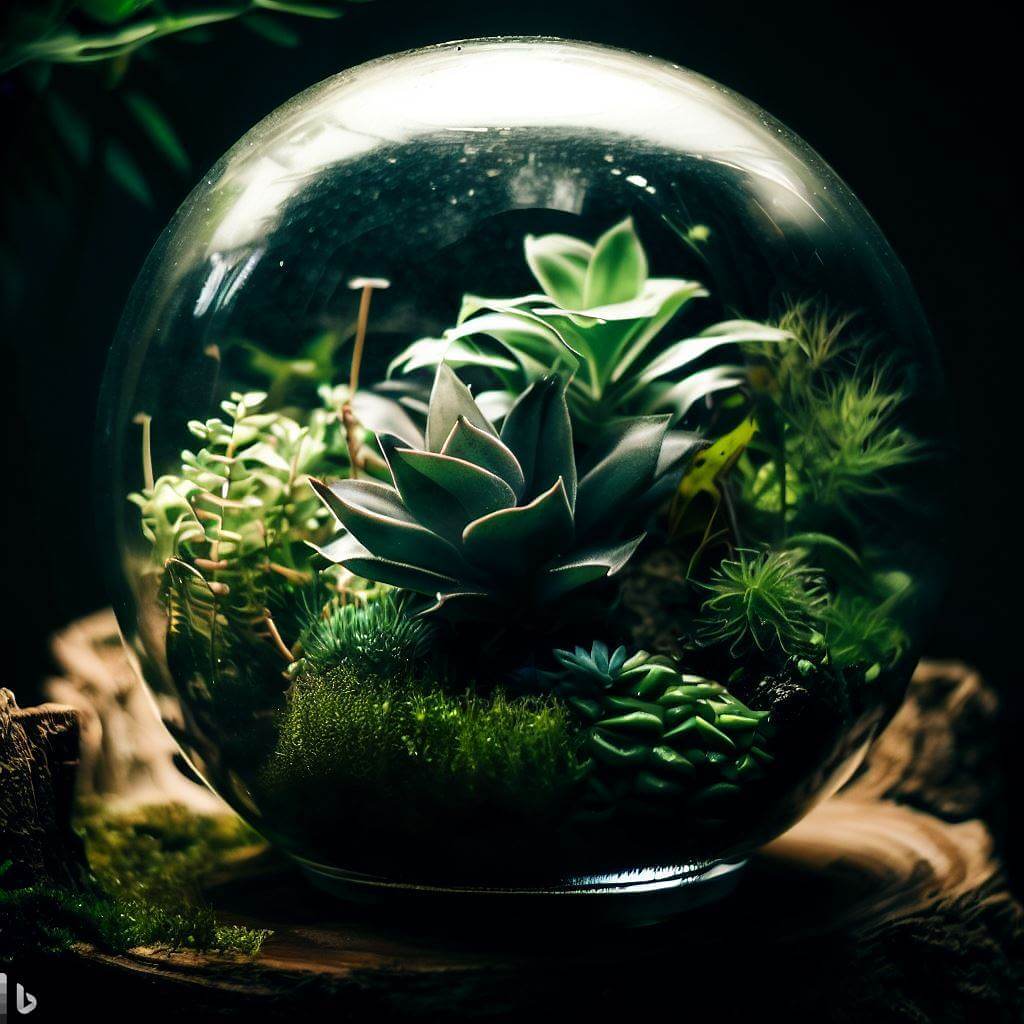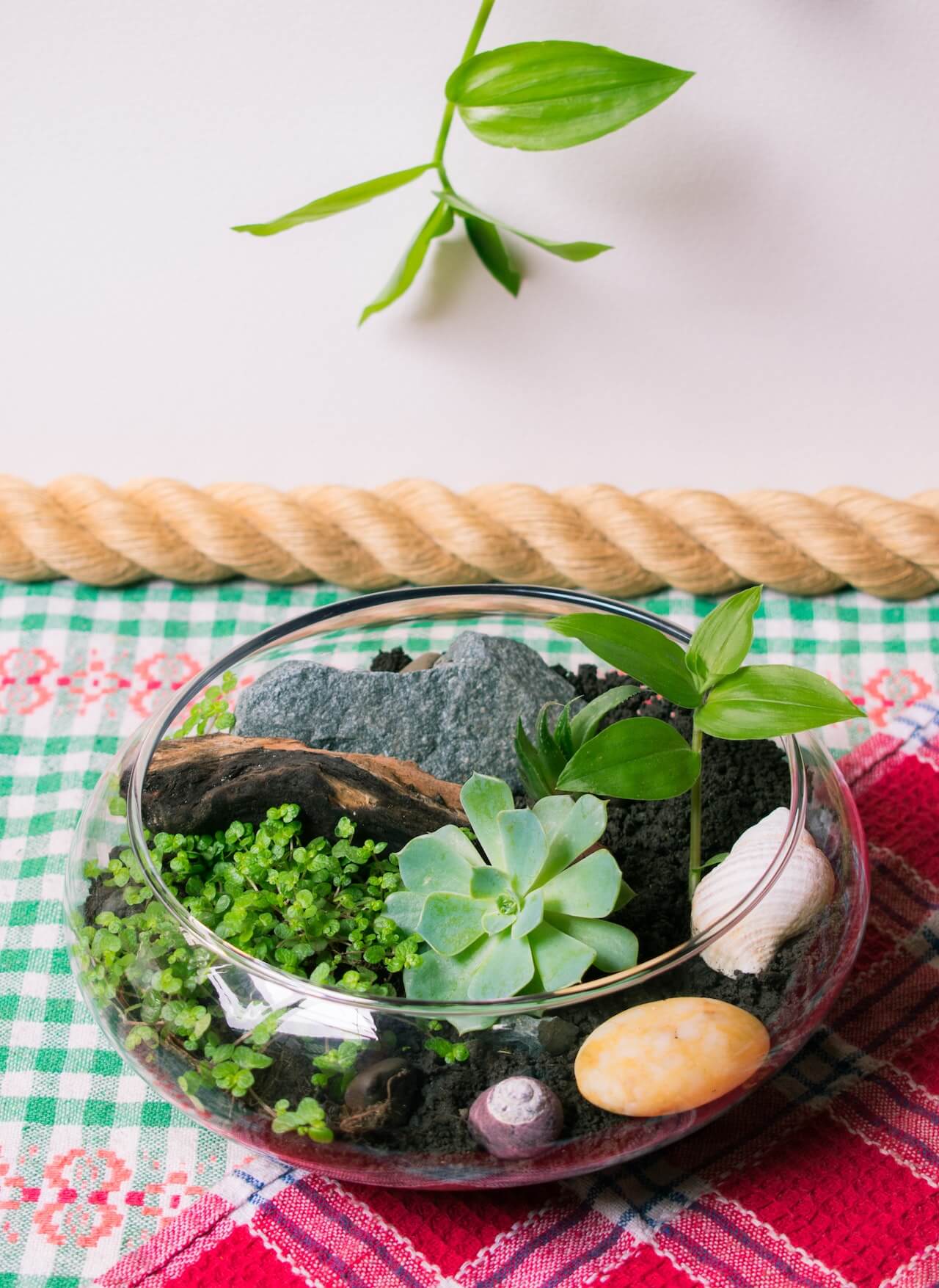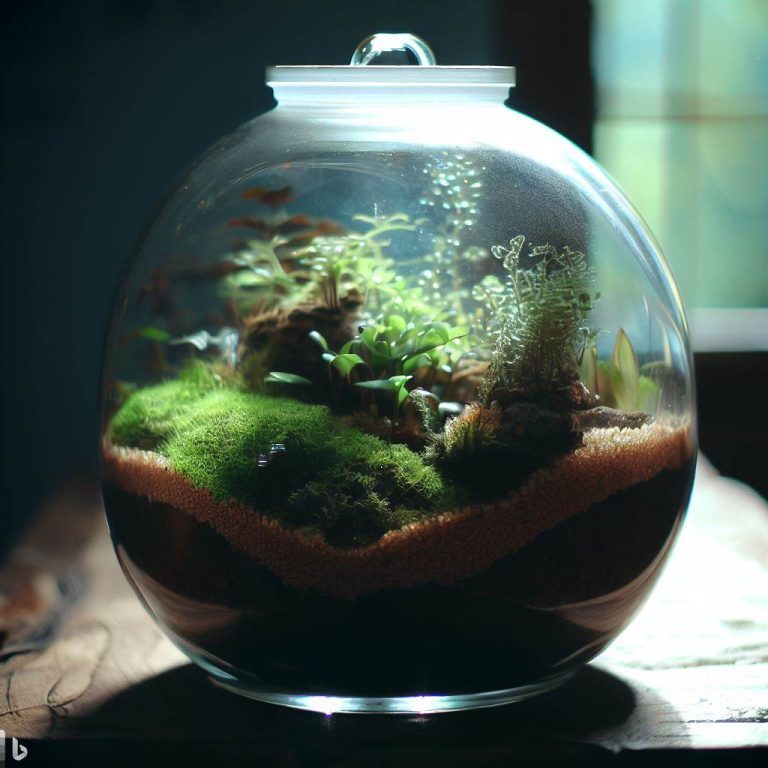How Do Terrariums Work? If you’ve ever wondered how these self-sustaining environments work, you’re in the right place. Whether you prefer a closed or open terrarium, these captivating gardens are sure to catch your eye and leave you curious about the science behind their success.
Terrariums are not just beautiful pieces of decoration, they are also a significant part of the plant world. These tiny gardens are self-contained environments that mimic natural habitats, creating an ideal place for plants to grow and thrive. This article will take you through the nitty-gritty of the science and maintenance behind terrariums.
Key Takeaways:
- Terrariums are miniature ecosystems that thrive inside a glass container.
- They are self-sustaining environments that mimic natural habitats for plants to grow and thrive.
- There are two types of terrariums, closed and open, each with its unique characteristics.
- The water cycle and photosynthesis are the key processes that sustain the plants in the terrariums.
- Choosing the right plants and proper care are essential for maintaining a healthy terrarium.
Understanding the Basics of Terrariums
So, you want to join the terrarium craze? Before you start picking out plants willy-nilly, let’s discuss the important components of a terrarium.
| Components | Importance |
|---|---|
| Enclosed Space | It’s essential to enclose the plants in a terrarium to create a mini-ecosystem. This keeps in the water vapor and allows for the water cycle to occur. |
| Proper Drainage | Without proper drainage, your plants will be left swimming in their own tears. Potting soil mixed with sand can help create a draining system. |
Now, onto the types of plants that work best in a terrarium.
- Succulents – These desert darlings love direct sunlight and require minimal watering.
- Ferns – These leafy wonders thrive in high humidity and indirect light.
Now that you understand the basics, it’s time to get your hands dirty and create your own enclosed paradise. Don’t forget to enclose and drain!

The Water Cycle in Terrariums
You may remember learning about the water cycle in grade school, but did you know that it plays a crucial role in the success of your terrarium?
First and foremost, the humidity inside your terrarium is a result of the water cycle. As water evaporates from the foliage and soil, it creates water vapor that becomes trapped inside the enclosed container. This vapor then condenses on the walls and top of the terrarium and eventually drips back down into the soil, creating a continuous cycle.
But why is humidity important for your terrarium plants? Well, because they absorb moisture through their leaves, and high humidity levels help them retain that moisture. This is especially important for plants that thrive in tropical environments, such as ferns and succulents.
In addition to providing moisture for your plants, the water cycle also plays a key role in the carbon dioxide cycle. As plants perform photosynthesis, they release oxygen and absorb carbon dioxide. In a sealed terrarium, the carbon dioxide released during respiration is absorbed by the plants and used during photosynthesis, creating a self-sustaining ecosystem.
But the water cycle doesn’t just happen on its own. It’s important to maintain a proper balance of moisture in your terrarium to prevent over-watering or drying out. Keep an eye on the foliage and soil, and adjust watering as necessary. If you notice excess moisture, try leaving the lid open for a period of time to allow the excess water to evaporate.
So there you have it – the water cycle in a terrarium is vital to the health and survival of your plants. Embrace it, maintain it, and watch your mini ecosystem thrive.
Photosynthesis and Plant Survival
So, you’ve enclosed your plants and given them a cozy home. But how do they survive? Photosynthesis, my dear reader! It’s the process by which plants convert light energy into chemical energy, allowing them to grow and thrive.
Now, here’s the catch – terrariums often rely on indirect sunlight, meaning your plants may not receive the same amount of light they would outdoors. This can impact the photosynthesis process and the growth of your terrarium plants. Keep an eye out for any signs of slow growth or yellowing leaves, which may indicate insufficient light.
But wait, there’s more! A poorly balanced terrarium ecosystem can lead to pesky rot, ultimately hindering the photosynthesis process. Remember, a self-sustaining terrarium requires the right balance of moisture, air, and light to ensure your plants not only survive, but thrive!
So, what can you do to ensure your terrarium plants are self-sustaining? Well, it’s important to choose plants that are able to self-sustain in a terrarium environment, such as succulents or ferns. And, as always, make sure to keep a close eye on your terrarium’s moisture levels and ensure proper drainage to prevent any unwanted rot.
By following these tips, you’ll be well on your way to creating a thriving, self-sustaining terrarium with healthy, happy plants!

Choosing the Right Plants for Your Terrarium
Now that you understand the basics of how a terrarium works, it’s time to consider the right type of plants for your project. Not all plants will thrive in a closed terrarium, so it’s essential to pick plants that can survive in this unique environment.
When choosing plants, consider the size of your terrarium container. You want to ensure the plants are not too big for the space inside. It’s also critical to pay attention to the type of terrarium you have. Closed terrariums work well with plants that don’t require direct sunlight, such as succulents and ferns.
Additionally, it’s crucial to pick plants that don’t release excess moisture, as this can cause waterlogging and negatively affect the water cycle. Choose plants that have shallow roots and prefer moist soil, and ensure the soil in the terrarium releases water vapor into the air.
Lastly, it’s essential to have a sealed container for your closed terrarium to prevent air circulation and retain humidity. If you opt for an open terrarium, you can choose a broader range of plants that can tolerate a drier environment.
To ensure your plants thrive, remember to provide proper terrarium care, such as regular watering and trimming. With the right plants and care, your terrarium will create a self-sustaining ecosystem, bringing a touch of nature into your home.
Closed or Open Terrarium: Which Is Best?
Ready to take the plunge and start your terrarium journey? One of the first decisions you’ll need to make is whether to go for a closed or open terrarium. Both have their pros and cons, so let’s take a closer look.
Closed Terrariums
In a closed terrarium, the plants are enclosed in a sealed container, creating a mini ecosystem. This type of terrarium creates high humidity levels, which can be great for certain plants like ferns and mosses. However, it’s important to carefully select the type of plants that will thrive in this environment.
One benefit of a closed terrarium is that it requires less watering than an open terrarium. The water cycle is self-sustaining, so you don’t have to worry about adding too much water. Plus, the container can be left untouched for months on end without needing attention.
However, the downside is that some plants may not do well in a closed environment. If you’re keen on growing succulents or other plants that don’t tolerate high humidity, a closed terrarium may not be the best option for you.
Open Terrariums
An open terrarium, on the other hand, allows for air circulation and can accommodate a wider range of plants. You can remove the lid and let your houseplants breathe freely. This means that growing plants like succulents and cacti is possible with an open terrarium.
The obvious downside of an open terrarium is that it requires more watering than a closed terrarium. You must monitor the soil moisture and add water as needed to keep the plants healthy. Additionally, an open terrarium can attract bugs and pests, so you’ll need to stay on top of that.
Ultimately, the choice comes down to the type of plants you want to grow, how much maintenance you’re willing to put in, and personal preference. Both closed and open terrariums can be beautiful additions to your home or office.
Conclusion How Do Terrariums Work
So, there you have it! You are now a terrarium expert, equipped with all the knowledge you need to create a thriving mini ecosystem in your home. Remember, when it comes to choosing the right plants for your terrarium, consider their suitability for open or closed environments. Also, proper care is essential for the health of the plants inside the terrarium. Fortunately, terrariums are low maintenance, so you won’t need to spend too much time tending to them. Just be mindful not to give them too much water – it’s a delicate balance. Now that you know the secrets of how terrariums work, it’s time to start experimenting with your own creation. Whether it’s an open or closed terrarium, you can have so much fun selecting the perfect plants for your home. So, get started and get creative – the plants in your terrarium will thank you for it!
Q: How do terrariums work?
A: Terrariums work by creating a miniature ecosystem inside a closed container, such as glass or plastic. This closed terrarium creates a self-sustaining environment where plants and moss can thrive with very little maintenance.
Q: What is a closed terrarium?
A: A closed terrarium is a type of terrarium that is completely sealed, meaning it does not have any drainage holes. This sealed environment allows for the recycling of moisture and nutrients, creating a self-nourishing ecosystem.
Q: What types of plants are suitable for terrariums?
A: Plants that need a high level of humidity and thrive in low-light conditions are great choices for terrariums. Some examples include ferns, moss, tropical plants, and certain types of succulents.
Q: Do terrariums need water?
A: Yes, terrariums need water, but not as frequently as traditional potted plants. The closed environment of a terrarium helps retain moisture, so you only need to water them sparingly. It’s important to monitor the moisture levels and avoid overwatering.
Q: How do terrariums maintain themselves?
A: Terrariums maintain themselves through a process called the water cycle. The plants and moss inside the terrarium release moisture into the air through transpiration. This moisture condenses on the walls of the terrarium and eventually drips back into the soil, providing a continuous supply of water and nutrients.
Q: Are terrariums easy to maintain?
A: Yes, terrariums are generally easy to maintain. Once properly set up, they require very little attention. Just make sure to remove any dead leaves or plants to prevent mold or rot. Additionally, monitor the moisture levels and adjust watering accordingly.
Q: Can I place my terrarium in a sunny area?
A: While some terrariums may benefit from indirect sunlight, most closed terrariums prefer low to moderate light conditions. Placing them in direct sunlight can cause the temperature inside the terrarium to rise significantly, potentially harming the plants.
Q: Can I use artificial light for my terrarium?
A: Yes, you can use artificial light to provide the necessary light for your terrarium if natural light is limited. LED grow lights or fluorescent bulbs can be used to simulate sunlight and help the plants in your terrarium grow.
Q: Can I open the lid of my closed terrarium?
A: Opening the lid of a closed terrarium should be done sparingly, and only if absolutely necessary. The closed environment is essential for maintaining the humidity and moisture levels. If you need to open the lid, do it briefly and only to address specific maintenance tasks.
Q: What should I do if my terrarium plants are growing too much?
A: If your terrarium plants are growing too much and taking over the limited space, you can trim them back to keep them in check. Pruning the plants will help maintain the balance within the terrarium and prevent overcrowding.
